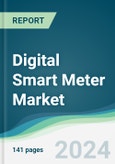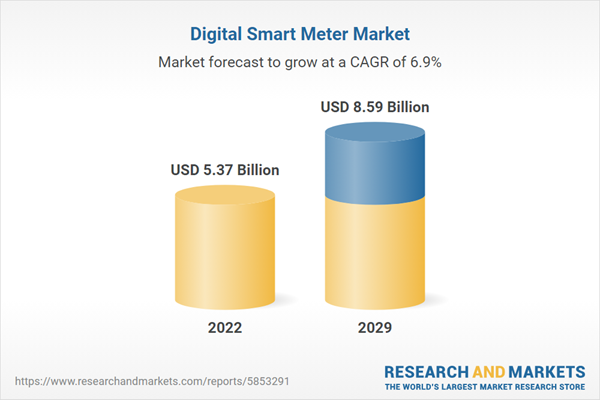A digital smart meter represents a technologically advanced electronic device utilized for measuring and overseeing energy usage across residential, commercial, and industrial environments. Offering real-time data on energy consumption, these meters empower consumers and utility companies to effectively manage and optimize energy resources.
The surge in energy costs and mounting concerns regarding climate change are compelling both consumers and utilities to embrace energy-efficient solutions. By furnishing instantaneous insights into energy consumption, digital smart meters enable users to make informed decisions and potentially curtail their energy usage.
Numerous governments are actively endorsing the deployment of smart meters through various incentives such as subsidies, tax benefits, or obligatory installation mandates. Moreover, stringent environmental regulations aimed at mitigating greenhouse gas emissions serve as an additional impetus for the widespread adoption of smart meters as a means of energy consumption management.
Digital smart meters often serve as the linchpin of an Advanced Metering Infrastructure (AMI) system, facilitating the collection, analysis, and transmission of energy data for utilities and consumers alike. This integrated approach is fueling the escalating demand for smart meters.
Equipped with digital displays offering detailed information, including current energy consumption, voltage levels, and historical usage patterns, these meters are fulfilling the growing requirement for precise energy measurements in residential, commercial, and industrial settings, thereby propelling their market growth.
Market Drivers:
The rise in energy consumption in residential and commercial settings is boosting market growth.
As electricity costs rise and sustainability becomes a growing concern for residential consumers, there's a heightened interest in reducing energy bills and carbon footprints. Digital smart meters offer homeowners real-time insights into their energy usage, empowering them to make informed decisions about consumption patterns and pinpoint areas for improved efficiency.The increasing energy consumption observed in both residential and commercial environments is catalyzing market expansion. With the escalating costs of electricity and a heightened awareness of sustainability among residential consumers, there is a growing interest in minimizing energy bills and reducing carbon footprints.
The surge in electricity consumption across both residential and commercial sectors is propelling the demand for digital smart meters. According to data from iea.org, global energy investments in 2022 reached $1.74 trillion in clean energy and $1.05 trillion in fossil fuels, underscoring the increasing focus on clean energy solutions. Projections indicate that global electricity demand growth will experience a slight easing in 2023 before picking up pace in 2024, with an anticipated growth rate of just under 2% in 2023, down from 2.3% in 2022. China, in particular, is expected to witness a notable increase in electricity demand, projected to rise by 5.3% in 2023 and 5.1% in 2024.
Digital smart meters emerge as a solution by offering homeowners real-time visibility into their energy consumption, enabling them to make well-informed decisions regarding usage patterns and identify areas for enhanced efficiency. Equipped with this valuable information, commercial establishments can make data-driven decisions to boost efficiency and achieve cost savings through the real-time monitoring and management of energy consumption.
Surge in technology adoption for energy measurement in industrial sectors is propelling the demand for digital meters
Industrial establishments are increasingly recognizing the importance of monitoring and managing their energy consumption to optimize operational efficiency and reduce costs. Digital smart meters have emerged as powerful real-time tools for capturing and analyzing energy data. These meters enable industries to monitor their energy consumption patterns, identify energy wastage, and implement targeted energy-saving measures.Digital smart meters can now be interconnected within a network, enabling seamless data transmission and centralized monitoring. Additionally, cloud-based platforms enable industries to store, analyze, and visualize energy data, facilitating real-time decision-making and enabling proactive energy management strategies. The rising adoption of technology for energy measurement in industrial sectors boosts the digital meter market growth.
Data-driven decision making
The wealth of data obtained from smart meters presents invaluable opportunities for both utility providers and consumers alike. Utility companies can utilize this data to implement targeted energy-saving initiatives and make informed decisions regarding infrastructure investments. Similarly, consumers can leverage this information to gain insights into their energy consumption patterns, thereby identifying areas where energy usage can be optimized and potentially reduced.In various sectors spanning from commercial to residential domains, as well as industries like manufacturing and healthcare, organizations are capitalizing on the power of data to enhance efficiency, lower costs, and maintain a competitive edge. Energy monitoring systems, in particular, have emerged as crucial tools in predicting equipment failures, thus minimizing costly downtime and prolonging the lifespan of vital machinery.
Furthermore, many businesses have committed to sustainability objectives aimed at reducing their carbon footprint. Energy monitoring plays a pivotal role in tracking progress towards these goals, providing the necessary data to assess performance and make adjustments as required. Compliance with energy efficiency regulations is paramount for businesses operating in diverse regions. Energy monitoring systems ensure that organizations remain in adherence to these regulations, thereby avoiding potential penalties and upholding their commitment to environmental responsibility.
Market Restraint:
High installation cost as a restraint
The installation of smart meters necessitates substantial initial investment for utility companies and, occasionally, end users. This encompasses expenses related to purchasing the meters, upgrading communication infrastructure, implementing data management systems, and possibly conducting customer education initiatives.APAC is anticipated to hold a significant share of the digital smart meter market.
The Asia-Pacific region is expected to hold a sizable market share due to the rising electricity consumption coupled with efforts to develop clean energy for domestic usage, driving the demand for energy management solutions. According to the India Brand Equity Foundation (IBEF), in 2022, the National Smart Grid Mission (NSGM) by the Indian government deployed 516 hundred thousand smart meters till November 2022, with 611 hundred thousand more to be implemented.Market Developments:
- February 2024- Itron, Inc. unveiled the Itron Enterprise Edition (IEE) Cloud. This enterprise-grade Meter Data Management (MDM) platform was exclusively developed for the cloud, catering to the evolving requirements of modern utilities as they transition towards digitalization.
- September 2022-. Delving launched a digital smart meter called "DelSmart IoT Meter," which was an Internet of Things (IoT) driven product working on the cloud, and would help reduce energy losses, result in power saving, and ensure the safety of electrical equipment on the premises of the user.
- February 2022- Abb India launched "M1M11," which offers a huge potential for customers to manage the energy performance of commercial and industrial buildings.
Market Segmentation:
By Type
- Single Phase
- Three Phase
By End-User
- Residential
- Commercial
- Industrial
By Geography
- North America
- USA
- Canada
- Mexico
- South America
- Brazil
- Argentina
- Others
- Europe
- Germany
- France
- UK
- Spain
- Others
- Middle East and Africa
- Saudi Arabia
- UAE
- Others
- Asia Pacific
- China
- Japan
- India
- South Korea
- Australia
- Others
Table of Contents
Companies Mentioned
- ABB Ltd.
- Aclara Technologies LLC (Hubbell Incorporated)
- Holley Technology Ltd. (Zhejiang Huamei Holding)
- Honeywell International Inc.
- Iskraemeco Group
- Itron Inc.
- Networked Energy Services
- Schneider Electric
Table Information
| Report Attribute | Details |
|---|---|
| No. of Pages | 141 |
| Published | March 2024 |
| Forecast Period | 2022 - 2029 |
| Estimated Market Value ( USD | $ 5.37 Billion |
| Forecasted Market Value ( USD | $ 8.59 Billion |
| Compound Annual Growth Rate | 6.9% |
| Regions Covered | Global |
| No. of Companies Mentioned | 8 |









